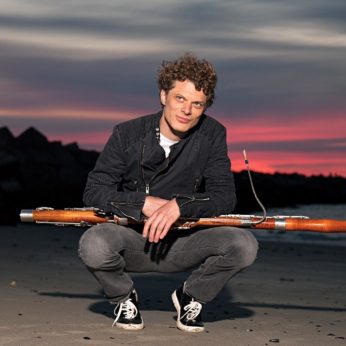Composer: Carl Nielsen (b. 1865 - d. 1931)
Performance date: 26/06/2022
Venue: St. Brendan’s Church
Composition Year: 1922
Duration: 00:26:04
Recording Engineer: Simon Cullen, Ergodos
Instrumentation: fl, ob, cl, bn, hn
Instrumentation Category:Wind Quintet
Artists:
Orsino Ensemble (Adam Walker [flute], Emmanuel Laville [oboe], Matt Hunt [clarinet], Alec Frank-Gemmill [horn] Bram van Sambeek [bassoon]) -
[Wind Quintet]

Carl Nielsen [1865-1931]
Wind Quintet Op. 43 [1922]
1. Allegro ben marcato
2. Minuet
3. Praeludium
4. Tema con variazioni
This genial work, which Nielsen wrote in 1922 as a relaxation from the rigours of his 5th Symphony, has become one of the most widely played of 20th century wind quintets. It is central to his genius and effectively sums up the composer’s abilities at the height of his powers, for it is more than attractive entertainment music; it has considerable depths and an idiosyncratically original treatment of tonality. The Quintet also inaugurated a way of composing based on the character of the individual instruments. Nielsen was very fond of wind instruments, perhaps as part of his fascination with nature and living – breathing – things, and in 1925 he said that in his 6th Symphony he had tried to reveal the individual characters of the woodwind instruments: Each instrument is like a person who sleeps, whom I have to wake to life. I think through the instruments themselves, almost as if I had crept inside them. He wrote the Wind Quintet for five friends and each part is made to suit the individuality of each player. He also intended to write a concerto for each of the players, but only lived to complete those for flute and clarinet. The irascible temperament of the clarinettist, for example, is strongly suggested in the Quintet, and later confirmed by the fierce nature of the Clarinet Concerto.
The first movement is in sonata form, complete with repeat (which is required because of the ten elaborate return bars). The themes are deceptively simple and there are a surprising variety of sonorities and blends from the five instruments, surprising because one of the difficulties of the wind quintet combination is that the instruments do not blend. The Minuet is full of cheeky two- and three-part writing and is followed by a humourously sinuous trio that is reminiscent of the Dance of the Cockerels from his opera Maskarade. The oboist changes to cor anglais for the third movement which is a pensive, rather grim Adagio prelude to the simplicity of the opening of the fourth movement. Robert Simpson described the third movement as a rather wild rhapsodic nature study.
Early in 1922 attacks of angina had forced Nielsen to slow down his activities, and as he was to do at other times of crisis, he turned to religious texts. He was not an orthodox believer and he had no belief in the afterlife, but he was committed to purity and simplicity in music and this is related to his use of religious texts. Many of his hymns and religious songs are used in Denmark and for the theme of the fourth movement of the Wind Quintet he used one of his own hymns that was already well-known: Min Jesus, lad min Hjerte faa en saaden mag paa dig (‘My Jesus, let me love you with all my heart, that my soul never lose you’). He knew that its familiarity would emphasise the irreverence of the eleven humorous variations that follow the very simple statement of the hymn tune.
The first variation features the mellow horn and the next is for a subtly humorous dancing flute. In the oboe’s plaintive variation the other instruments do mischievous things to the harmonies. This is followed by an interlude like a variation for military band that is played by the full ensemble, and then the angry clarinet tries to stir up the untroubled bassoon. A reflective variation for the full ensemble is next and is followed by the solo bassoon. Nielsen portrays the serious side of the instrument, a quite different character from the humorous peasant role it had during the minuet. The next variation features the oboe over an almost Scottish drone bass, and it is followed by a cadenza-like variation for solo horn. The flute leads the other instruments in exploring variations on the tune, and then the clarinet plays a syncopated version of the hymn. After a faster, fragmentary section there is a final solemn restatement of the theme.
Sarah M. Burn
Copyright © 2025 West Cork Music. All rights reserved.
Designed and developed by Matrix Internet